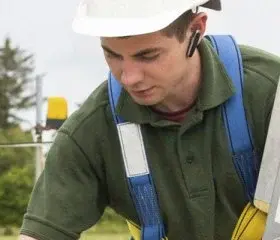/worker-from-above-banner.jpg?width=300&name=worker-from-above-banner.jpg)
SYSTEMATICALLY MANAGE WORKING AT HEIGHTS
Falls from heights account for many injuries and deaths in the Australian workforce - and nearly all of these are preventable. Follow this guide to ensure that employees working in high places do not endanger themselves or other people on the ground that are exposed to falling objects.
Any work at heights should be the subject of a Permit to Work. This should include work on roofs or other high places such as scaffolding or high walkways. Specifically, a Permit to Work should be issued for any task that involves a fall hazard (i.e. in VIC, a fall of at least 2 metres) and is required to be undertaken:
- on any plant or structure being constructed, demolished, inspected, tested, maintained, repaired or cleaned
- on a fragile, slippery or potentially unstable surface
- using equipment to gain access to an elevated level or to carry out the task at an elevated level
- on a sloping surface that makes it difficult to maintain balance
- in close proximity to an unprotected edge
- in close proximity to a hole, shaft or pit which is of sufficient dimensions to allow a person to fall into the hole, shaft or pit
The Permit Issuer should consider hazards such as the fall of personnel and falling objects (materials, tools, etc) which may endanger persons below. Wherever possible, Elevated Work Platforms should be used in lieu of personnel climbing on structures.
Prior to the issue of a Permit to Work, a risk assessment of the task should be conducted.
When conducting the risk assessment, the following hierarchy of controls for working at heights should be utilised:
- the task should be carried out on the ground or on a solid construction or, if this is not practicable;
- a passive fall prevention device such as a temporary work platform, roof safety mesh or guard-railing should be used, or, if this is not practicable;
- a work positioning system should be used, or if this is not practicable;
- a fall injury prevention system should be used, or if this is not practicable;
- a fixed or portable ladder or an administrative control should be used.
The selected control measures should be included in the Permit to Work and the personnel carrying out the work should comply with all the control measures and precautions, as specified.
Full records of the Permits and selected control measures should be kept for a period of 2 years.
Roofs on which personnel are required to work should be as specified in Australian Standard AS 1562. Any other roofs should be considered as fragile. The installation of permanent walkways and stairs should be considered for roofs where regular access is required (e.g. cleaning, maintenance. or inspection of roof-mounted equipment).
Fragile roofs should be sign-posted and special means such as crawl-boards used. In addition, skylights and roof openings should be identified and measures taken to prevent persons walking on them, e.g. by barricading or use of a restraint system. Where it is impracticable to physically prevent access to such openings, a fall arrest system should be used, including the use of safety harness and effective anchorage point.
Work on scaffolding should only be on complete scaffolding, unless the work involves erection or dismantling of the scaffolding.
All personnel involved in scaffolding and rigging work should hold the appropriate certificate of competency in accordance with the National Occupational Health and Safety Certification Standard for Users and Operators of Industrial Equipment.
Download Your Free Checklist PDF
Get instant access to our expert-designed checklist to help you. Simply fill out the form below to download your copy.Need a Safer Approach to Working at Heights?
Our safety consulting services help you assess risks, strengthen controls, and implement practical, system-based solutions.SIMILAR READINGS

2 min read
2 min read
Keep contractors and consultants safe on your work...
Read More
4 min read
4 min read
Protect your staff with a rigorous and systematic Permit to...
Read More
2 min read
2 min read
Ensure optimum safety for workers working on elevated...

4 min read
4 min read
Small accidents can have a big impact; reduce their...
Read More